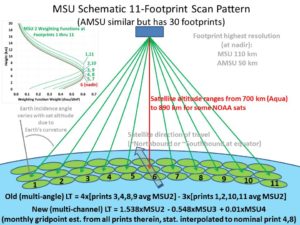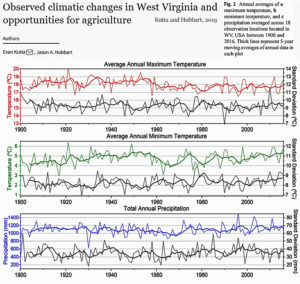by Univ. of California – Berkeley, February 21, 2019 in ScienceDaily
Based on new data published today in the journal Science, it seems increasingly likely that an asteroid or comet impact 66 million years ago reignited massive volcanic eruptions in India, half a world away from the impact site in the Caribbean Sea.
But it leaves unclear to what degree the two catastrophes contributed to the near-simultaneous mass extinction that killed off the dinosaurs and many other forms of life.
The research sheds light on huge lava flows that have erupted periodically over Earth’s history, and how they have affected the atmosphere and altered the course of life on the planet.
…
by JC Maurin, 22 février 2019 in ScienceCimatEnergie
Afin d’élaborer les indicateurs de température, on utilise des radiomètres MSU, AMSU ou ATMS embarqués sur des satellites, puis on construit l’indicateur à partir des mesures et de diverses corrections. On obtient ainsi un indicateur qui concerne la quasi-totalité du globe, contrairement aux indicateurs terrestres basés essentiellement (avant 1980) sur quelques milliers de stations américaines et européennes. Au sujet des mesures par satellites, et sans être spécialiste dans ce domaine, un physicien peut néanmoins donner quelques éléments d’appréciation qu’ignore parfois un lecteur intéressé par la climatologie. Le but de la seconde partie de l’article sera atteint si ce lecteur a appris des éléments nouveaux, il pourra ensuite approfondir la question par lui-même.

…
by Anthony Watts, February 21, 2019 in WUWT
NWS Las Vegas writes:
The Las Vegas Valley Snow Event: What happened? Did we see this coming? Yes and no. We had been seeing very small chances for snow in the valley for a few days, but it wasn’t until Sunday afternoon that the hi-resolution models were consistently indicating that western parts of the valley could see up to 3 inches and up to an inch elsewhere. That’s when the decision was made to issue the Winter Weather Advisory.

by K. Richard, February 21, 2019 in NoTricksZone
“Between 1900 and 2016, climatic trends were characterized by significant reductions in the maximum temperatures (−0.78°C/century; p = 0.001), significant increases in minimum temperatures (0.44 °C/century; p = 0.017) [overall -0.34°C/century], and increased annual precipitation (25.4 mm/century) indicative of a wetter and more temperate WV climate. Despite increasing trends of growing degree days during the first (p ≤ 0.015) and second half of the period of record, the long-term trend indicated a decrease in GDD [warm growing degree days] of approximately 100 °C/days.”

La géologie, une science plus que passionnante … et diverse



